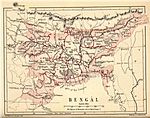
Back अंग महाजनपद ANP অঙ্গ Bengali/Bangla Anga Catalan Anga Czech Ango EO Anga Spanish Anga Finnish Anga (royaume) French Anga GL अंग महाजनपद HI
Aṅga | |||||||
|---|---|---|---|---|---|---|---|
| Unknown (~1100 BCE)–c. 530 BCE | |||||||
 Aṅga and other kingdoms of the late Vedic period | |||||||
 | |||||||
| Capital | Champapuri (near modern Bhagalpur) and Malini (near modern Munger), Bihar | ||||||
| Religion | Historical Vedic religion Buddhism Jainism | ||||||
| Government | Monarchy | ||||||
• | Brahmadatta | ||||||
| Raja (King) | |||||||
| Historical era | Iron Age | ||||||
• Established | Unknown (~1100 BCE) | ||||||
• Disestablished | c. 530 BCE | ||||||
| |||||||
| History of Bengal |
|---|
 |
Anga [a] was an ancient Indo-Aryan tribe of eastern India whose existence is attested during the Iron Age. The members of the Aṅga tribe were called the Āṅgeyas.[1]
Counted among the "sixteen great nations" in Buddhist texts like the Anguttara Nikaya, Aṅga also finds mention in the Jain Vyakhyaprajnapti's list of ancient janapadas.
Cite error: There are <ref group=lower-alpha> tags or {{efn}} templates on this page, but the references will not show without a {{reflist|group=lower-alpha}} template or {{notelist}} template (see the help page).
- ^ Raychaudhuri 1953, p. 106-110.